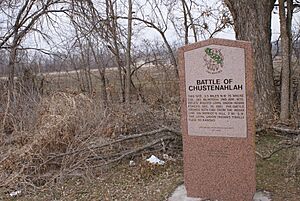Battle of Chustenahlah facts for kids
Quick facts for kids Battle of Chustenahlah |
|||||||
|---|---|---|---|---|---|---|---|
| Part of the Trans-Mississippi Theater of the American Civil War |
|||||||
|
|||||||
| Belligerents | |||||||
| Creeks Seminoles |
|||||||
| Commanders and leaders | |||||||
| Opothleyahola | Douglas H. Cooper James M. McIntosh Stand Watie |
||||||
| Strength | |||||||
| 1,700 men | 1,380 men | ||||||
| Casualties and losses | |||||||
| 250 killed and wounded 180 people captured | 9 killed 40 wounded |
||||||
The Battle of Chustenahlah was a fight during the American Civil War. It happened in Osage County, Oklahoma, which was then called Indian Territory. The battle took place on December 26, 1861. After this battle, about 9,000 Native Americans who supported the Union were forced to leave their homes. They had to travel to Kansas in very cold and snowy weather. This difficult journey became known as the Trail of Blood on Ice.
Contents
Why the Battle Happened
Confederate Goals in Indian Territory
During the Civil War, the Confederate forces wanted to control Indian Territory. They aimed to stop Native Americans who supported the Union. They also wanted to make sure the area was under Confederate control.
Earlier Fights
Before Chustenahlah, Confederate troops had already attacked Chief Opothleyahola's group. This group included Creek and Seminole people. These earlier battles happened at Round Mountain and Chusto-Talasah.
Planning the Attack
The Confederates wanted to defeat these Native American groups completely. They planned to attack their camp at Chustenahlah. This camp was in a hidden area on Bird Creek. The name Chustenahlah comes from a Cherokee word. It means "a shoal or sandbar in a stream or creek."
Confederate Commanders and Forces
Colonel James M. McIntosh and Colonel Douglas H. Cooper led the Confederate forces. They planned to attack the camp from different directions. McIntosh left Fort Gibson on December 22 with 1,380 soldiers.
Who Fought in the Battle
Confederate Side
Colonel James McQueen McIntosh led the Confederate soldiers. His group included:
- Soldiers from Texas Cavalry units.
- Soldiers from the 2nd Arkansas Mounted Rifles.
- Other smaller companies.
Union Native American Side
The main leaders for the Union-supporting Native Americans were:
- Chief Opothleyahola (Creeks).
- Chief Halek Tustenuggee (Seminoles).
- Sonuk Mikko (Billy Bowlegs) (Seminoles).
The Battle of Chustenahlah
McIntosh's Decision to Attack
On December 25, McIntosh learned that Cooper's forces could not join him right away. Even so, McIntosh decided to attack the next day. He chose to fight despite being outnumbered and facing very cold weather.
The Attack Begins
McIntosh's troops attacked the camp at noon on December 26. About 1,700 Union-supporting Native Americans were hiding. They were in the thick bushes on a rugged hill. McIntosh planned for his soldiers to meet at the top of the hill.
Confederate Movements
One group of Texas Cavalry soldiers was ordered to charge directly up the steep hill on foot. Another group, the 11th Texas, moved to their left. They used a hidden path for cover. The 6th Texas circled around to the right side.
The Retreat of the Native Americans
As the Confederate attack continued, the Native Americans started to fall back. They would hide for a short time and then move further back. Soon, their retreat turned into a full escape as the Confederates reached their camp. The Union-supporting Native Americans tried to defend their position. However, they were forced to leave by 4:00 p.m.
After the Main Fight
The Native American survivors fled. Many traveled all the way to Kansas, where they found other Union supporters. Colonel Stand Watie, leading 300 Cherokee soldiers fighting for the Confederacy, stopped some of the fleeing Creek and Seminole people. He and his men killed 15 of them. After this, Chief Opothleyahola's group did not fight back anymore. The Confederates did not follow them further.
The Journey to Kansas
The remaining Union fighters and their families walked to Fort Row, Kansas. They had lost many of their supplies because they had to leave so quickly. Sadly, nearly 2,000 people died during or shortly after arriving in Kansas. Most of these deaths were due to the cold weather and diseases.
What Happened After the Battle
Confederate Gains
The Confederates won the battle. They captured many things from the Native American camp. This included about 160 women and children, 20 African Americans, 30 wagons, and many animals. They also took a lot of supplies.
Casualties
The Confederates had 9 soldiers killed and 40 wounded. Colonel McIntosh reported that about 250 Union-supporting Native Americans were killed or wounded. He also reported that 180 people were captured.
Images for kids





